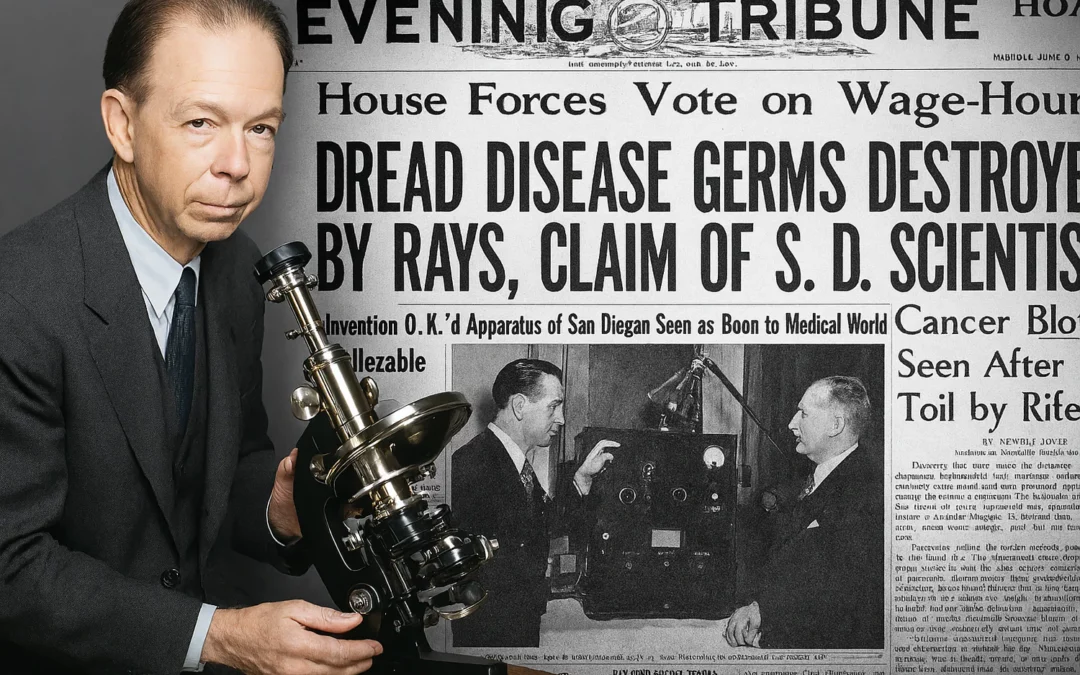Microscopes, Telescopes, and the Misplaced Frequency Narrative
Showing a microscope while talking about frequency (Hz) is like showing a telescope and talking about musical notes a fundamental mismatch of tools and concepts. Microscopes are designed to magnify tiny objects, such as cells or microbes, using light and lenses. They don’t generate or measure frequencies, which are cycles per second (Hz) typically associated with audio, radio, or electronics. Similarly, a telescope observes distant stars, not musical pitches. This analogy perfectly captures the confusion surrounding Royal Raymond Rife’s legacy, where his optical microscopy work has been conflated with modern frequency therapy.
Royal Rife, an American inventor in the early 20th century, developed the Universal Microscope, a groundbreaking device capable of observing live microorganisms at magnifications up to 60,000x. His work centered on optics and light, using specific wavelengths to illuminate pathogens, not on audio or electromagnetic frequencies measured in Hz. Historical records, including photographs, show Rife working with his “Beam Ray” device, which emitted light-based radio waves to target cancer cells, not the Hz-based frequencies popularized today. Nowhere in Rife’s documented work did he mention frequency charts or Hz systems, yet his name is synonymous with frequency therapy. This disconnect raises questions about the origins of so-called “Rife frequencies” and their validity.
The Mysterious Origins of Rife Frequency Charts
Modern “Rife frequency charts” list specific Hz values purportedly linked to ailments like cancer, infections, or chronic pain. These charts are widely circulated in alternative health communities, yet their origins are unclear. No primary documents from Rife’s era confirm that he created or used such charts. His focus was on optical resonance to observe and disrupt pathogens, not on generating audio or electromagnetic frequencies. The emergence of these charts likely dates to the late 20th century, when Rife’s suppressed legacy was revived by alternative health practitioners. These individuals may have adapted his ideas to fit emerging technologies like bioresonance or TENS (Transcutaneous Electrical Nerve Stimulation) devices, branding them as “Rife” for marketing appeal.
The lack of historical evidence suggests that these charts were not created by Rife himself but by later proponents capitalizing on his name. This raises ethical concerns about authenticity and transparency. Without verified sources, users of these charts are left experimenting with untested frequencies, often unaware of the potential risks involved.
The Dangers of Untested Frequencies
Using unvalidated or incorrect frequencies can be as dangerous as taking the wrong medication. The human biofield the subtle electromagnetic field surrounding the body interacts with external frequencies, and misapplied frequencies can disrupt cellular function, brainwave patterns, or physiological balance. For instance, studies on pulsed electromagnetic field (PEMF) therapy indicate that excessive or inappropriate frequencies can cause adverse effects, such as increased inflammation or neurological overstimulation. In extreme cases, a wrong frequency could exacerbate symptoms, create long-term imbalances, or, as some practitioners warn, “set you back for years” by distorting the biofield.
The analogy of Russian Roulette is fitting: many frequency therapy devices come with generic or speculative frequency lists, leaving users to test them blindly. Just as taking an untested drug can lead to severe side effects, an incorrect frequency might cause harm that’s difficult to reverse. Unlike pharmaceuticals, which undergo rigorous clinical trials, frequency therapy devices often lack standardized testing, amplifying the risk.
The Ethics of Frequency Therapy
The ethical implications of frequency therapy are significant yet rarely discussed. Ethical practice demands rigorous scientific validation, transparent communication of risks, and informed consent from users. However, the frequency therapy industry often prioritizes anecdotal success stories over empirical evidence, leaving consumers vulnerable to misinformation. The lack of regulation for wellness devices allows manufacturers to market untested products, sidestepping accountability. This raises questions about why the industry outside of exceptions like the PEMF Healing App rarely addresses the risks and ethics of frequency therapy.
The silence on these issues may stem from commercial incentives. Highlighting risks could deter sales, and the allure of Rife’s suppressed legacy makes unverified claims more marketable. Ethical frequency therapy requires a commitment to safety, evidence-based protocols, and clear user education to ensure that the benefits outweigh the risks.
The PEMF Healing App: A Science-Driven Alternative
The PEMF Healing App (www.pemfhealing.app) distinguishes itself by addressing these ethical and scientific gaps. Unlike devices relying on speculative “Rife” frequencies, the app integrates multiple modalities, including Electroherbalism, Whole Body Vibration (WBV), TENS, neuroreceptors, acupuncture, meridians, and brainwave modulation. Each frequency protocol is rigorously tested through soil, water, plant, and human trials to ensure safety and efficacy. This comprehensive approach combines advanced scientific knowledge with practical application, avoiding the pitfalls of unverified charts.
What sets the PEMF Healing App apart is its focus on rapid, measurable results. Many users report significant improvements within days, attributed to the app’s optimized frequency delivery and evidence-based design. By prioritizing transparency and safety, the app addresses the ethical shortcomings of the broader industry, offering a model for responsible frequency therapy.
Conclusion
The analogy of microscopes and musical notes highlights the misinterpretation of Royal Rife’s work, which focused on optics, not Hz-based frequencies. The mysterious origins of “Rife frequency charts” underscore the need for skepticism and validation in frequency therapy. Untested frequencies pose risks akin to incorrect medications, yet the industry rarely discusses these dangers or the ethical responsibilities involved. The PEMF Healing App stands out by combining validated science, diverse modalities, and a commitment to safety, offering a path forward for ethical frequency therapy. As the field grows, consumers must demand transparency and evidence to ensure that frequency therapy delivers on its promise without compromising safety.

